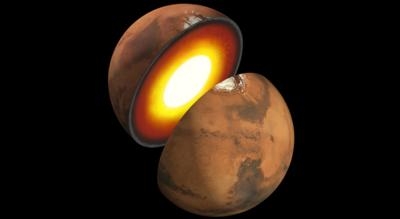But Their Evolution Has Been Very Different
A team of NASA scientists and their colleagues have found evidence from meteorites that Mars and Earth had a similar origin, but then the two planets evolved quite differently. Based on their analyses of two Martian meteorites, researchers in the Astromaterials Research and Exploration Science Directorate at NASA's Johnson Space Center have concluded that water in the Martian interior originated from planetary building blocks similar to those that formed Earth. This finding implies that chondritic meteorites containing small, granular minerals -- not comets -- are the source of water for terrestrial planets. The team’s findings are reported in the journal Earth and Planetary Science Letters.

Researchers also found that, unlike on Earth, rocks on Mars that contain atmospheric volatiles such as water were not recycled deep into the planet’s interior. If that had been the case, the primordial water the researchers found would have been overprinted by recycled water from Mars' atmosphere. Debates in the scientific community focus on how the interior and crust of Mars formed and how they differ from those of Earth. To investigate the history of Martian water and other volatiles, scientists at JSC, the Carnegie Institution in Washington, and the Lunar and Planetary Institute in Houston compared water concentrations and hydrogen isotopes trapped in crystals within the meteorites. Both were of the same primitive nature, but one was relatively rich in elements such as hydrogen, while the other wasn't.
“There are competing theories that account for the diverse compositions of Martian meteorites,” said Tomohiro Usui of Tokyo, Japan, lead author of the paper and a former NASA/LPI postdoctoral fellow who led the research. “Until this study there was no direct evidence that primitive Martian lavas contained material from the surface of Mars.”
"Usui revealed that the initial hydrogen isotopic composition of Mars was Earth-like, because he designed an experiment that greatly reduced contamination to the meteorite here on Earth,” said coauthor Justin Simon, a JSC cosmochemist.

Much controversy surrounds the origin, abundance and history of water on Mars. The sculpted channels of the Martian southern hemisphere speak loudly of flowing water, but that terrain is ancient. Consequently, planetary scientists often describe early Mars as “warm and wet” and current Mars as “cold and dry.” One meteorite appears to have changed little on its way to the surface of Mars from the Martian mantle. It has a hydrogen isotopic composition similar to that of Earth. The other meteorite appears to have incorporated some Martian crust that had contact with the Martian atmosphere. Thus the meteorites represent two very different sources of water. One sampled water from the deep interior and represents the water that existed when Mars formed as a planet, while the other sampled the shallow crust and atmosphere. “These meteorites contain trapped basaltic liquids, not unlike the basalts that erupt on Hawaii," said coauthor John Jones, a JSC experimental petrologist and
member of the Mars Science Laboratory rover team. "They are pristine samples that have sampled various Martian volatile element environments.”
From this, the team inferred that Martian surface water has had a different geologic history than Martian interior water. Most likely, atmospheric water has preferentially lost the lighter hydrogen to space and retained the heavier hydrogen isotope (deuterium).
That the enriched meteorite has incorporated crustal and atmospheric water could help solve an important mystery. Are Martian meteorites with components such as water coming from an enriched, deep mantle or have they been affected by interaction with the Martian crust? The hydrogen isotopic composition indicates the latter, so this meteorite tells scientists more about the Martian crust than about the Martian mantle. The other meteorite, however, yields more information about the Martian mantle, or interior.
The concentrations of water in the meteorites also are different. One has a low concentration that infers Mars' interior is dry. But the enriched meteorite has 10 times more water, suggesting the surface could have been very wet at one time. This could help scientists as they try to better understand the geologic history of Mars.
(Image provided by NASA)
 ANN's Daily Aero-Linx (06.29.25)
ANN's Daily Aero-Linx (06.29.25) ANN's Daily Aero-Term (06.29.25): Gross Navigation Error (GNE)
ANN's Daily Aero-Term (06.29.25): Gross Navigation Error (GNE) Classic Aero-TV: Anticipating Futurespace - Blue Origin Visits Airventure 2017
Classic Aero-TV: Anticipating Futurespace - Blue Origin Visits Airventure 2017 NTSB Final Report: Cirrus SR22
NTSB Final Report: Cirrus SR22 Airborne Affordable Flyers 06.26.25: PA18 Upgrades, Delta Force, Rhinebeck
Airborne Affordable Flyers 06.26.25: PA18 Upgrades, Delta Force, Rhinebeck




